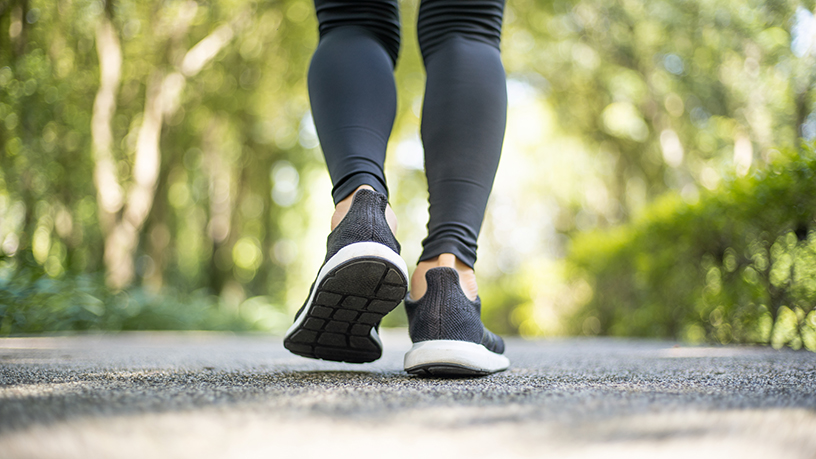On this page
Key takeaways
- Tracking your steps can be a great motivator to help you move more.
- You don’t necessarily need a smart watch to track your steps, there are multiple ways that don’t cost a cent.
- We share 5 ways to track your steps either using technology or using analogue alternatives.
Walking is a great way to stay healthy and happy. It can help you lose weight, boost your mood and even live longer.
While there’s no formal guideline in Australia on how many steps we should take each day, between 6,000 and 10,000 steps a day is a practical and motivating target for most adults, depending on your age and level of fitness.1
Whether you have a smart watch, a smart phone, or you prefer to do things the old-fashioned way, there are plenty of ways to keep track of your movement that are as easy as walking out the door!
Health & fitness apps
If you own a smartphone, you may already have a health and fitness app even without knowing it.
Apple iPhones, for instance, come with a pre-installed Health app. This holds a range of health data, including the distances you walk in a given day. The app can also help you figure out your average steps across time and even how many kilojoules you’ve burned.
To track your steps:
- Open the Health app.
- Tap Browse > Activity > Steps.
- You’ll see your daily step count, weekly trends, and averages.
- Make sure Fitness Tracking is enabled in your iPhone’s Settings under Privacy & Security > Motion & Fitness.
Google Fit is another popular health and fitness app available on most Android devices (and also downloadable on iOS). Like other physical activity monitors, it uses digital sensors to pick up on motion then records and stores that information for you.
To track your steps on Android:
- Open the Google Fit app (or download it from the Play Store).
- You’ll see a summary of your steps on the main screen.
- For more details, tap on the step count to explore your activity history, goals, and trends.
- Ensure your phone’s activity tracking permissions are turned on by going to Settings > Apps > Google Fit > Permissions, and enabling Physical activity access.
Specialised walking apps
There are dedicated walking apps that offer more detailed tracking and motivational features. These apps use built-in GPS and motion sensors to monitor your walks with greater precision, making them ideal for people who want to take their walking routine to the next level.
One popular option is Strava, which tracks your route, distance, time, pace, and even elevation. Originally designed for runners and cyclists, Strava works just as well for walking and hiking. It provides a map of your walk, personal performance stats, and lets you set goals or compete with your past records.
What makes Strava stand out is its social features. You can connect with friends, join virtual walking challenges, and share your progress with a supportive community. This can be a great way to stay motivated and accountable, especially if you're walking for fitness or training toward a goal.
Other great alternatives include MapMyWalk, AllTrails (great for bushwalks and hikes), and Walkmeter, which offer similar features tailored to walkers of all levels.
Fitness trackers
Wearable smart devices are a convenient and effective way to monitor your physical activity throughout the day, often more accurately than your phone alone. These devices, which include smartwatches, fitness bands, and chest straps, are designed to track your movement in real time and sync effortlessly with your smartphone via Bluetooth.
Popular brands include Apple Watch, Fitbit, Garmin, Xiaomi, Samsung Galaxy Watch, and WHOOP, each offering different features to suit a variety of fitness levels and budgets. Most wearables do far more than just count steps, they often include:
- Heart rate monitoring
- Sleep tracking and sleep quality insights
- Blood oxygen (SpO₂) monitoring
- Stress tracking and guided breathing exercises
- GPS tracking for walking, running or cycling routes
- Guided workouts and goal setting
Many of these devices integrate with health and fitness apps like Apple Health, Google Fit, and Strava, giving you a full picture of your activity, progress, and overall wellbeing.
Whether you're just starting a fitness journey or looking to optimise your performance, a wearable tracker can be a powerful daily companion.
Pedometers
If smartphone/wearable tracking isn’t for you, you might consider using this much simpler technology to track your steps. Typically, the humble pedometer uses mechanical sensors to count your steps, providing real-time data in a clean and simple way.
Interestingly, while pedometer technology may go back as far as Renaissance Italy, the device was popularised in the 1960s in Japan by a company that came up with the concept of ‘10,000 steps’. Today, there are many pedometer options that cater to different styles and price ranges.
Manually calculating your steps
If even a pedometer is too techy for you, there’s always the time-honoured, unvarnished approach to tracking your steps. You can calculate your walking distances with a stopwatch.
Of course, if you’re at this level of old-school you probably don’t need to be told how to manually calculate your steps. But, in case you did need a quick refresher, this is the general procedure:
- Determine how many steps you take on average per minute. You can do this by counting your steps for one minute 3 times, then finding an average based on that.
- Time your walk.
- Multiply the minutes you spent walking by your average steps per minute. So, a 20-minute walk at 100 steps a minute would equal 2,000 steps.
- Record your progress in a daily steps log. This can help you add up your daily steps and keep a reference of common walks for later use.
Whether high-tech or old-school, the best way to track your steps is the one that keeps you moving toward better health, one step at a time.

At Bupa, trust is everything
Our health and wellbeing information is regularly reviewed and maintained by a team of healthcare experts, to ensure its relevancy and accuracy. Everyone's health journey is unique and health outcomes vary from person to person.
This content is not a replacement for personalised and specific medical, healthcare, or other professional advice. If you have concerns about your health, see your doctor or other health professional.
You might also like
Why 10,000 steps? A simple path to a healthier you
You’ve probably heard that 10,000 steps a day is important for your health, but have you ever stopped to ask why?
The mental health benefits of walking
Walking is one of the best things you can do for your body. It’s also great for your mind.
4 ways to sneak more steps into your day
It can feel hard to get in those 10,000 steps in this busy world. But it might be easier than you think.
The power of walking
A simple stroll can be an overlooked activity with many health benefits. Find out how getting your daily steps in can help you march towards a healthier, happier you.





